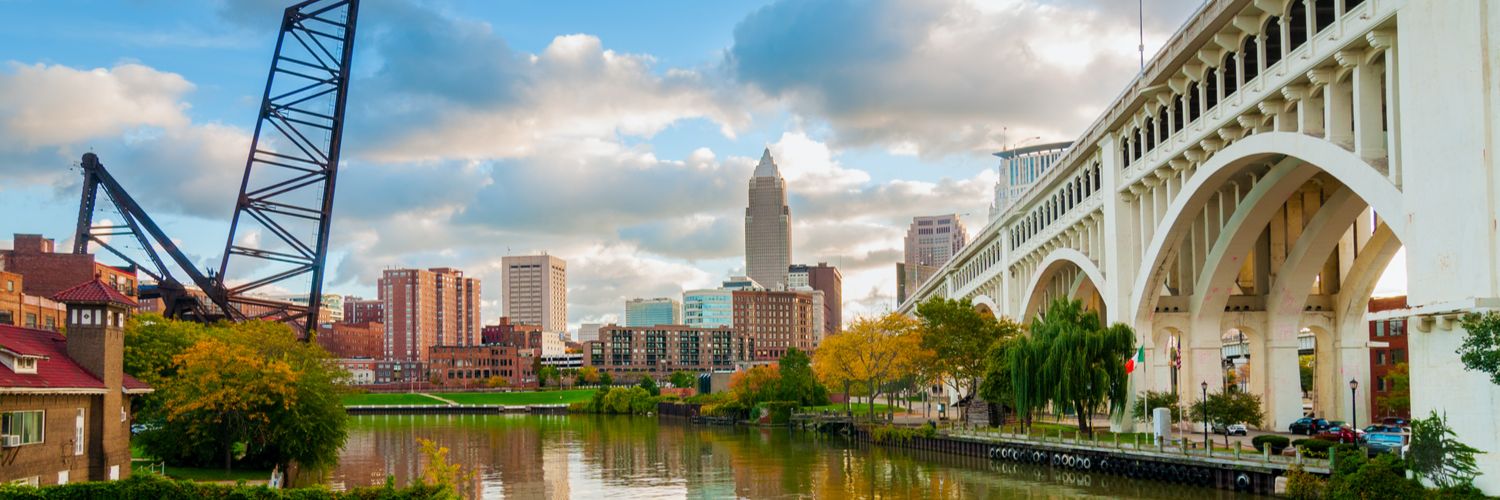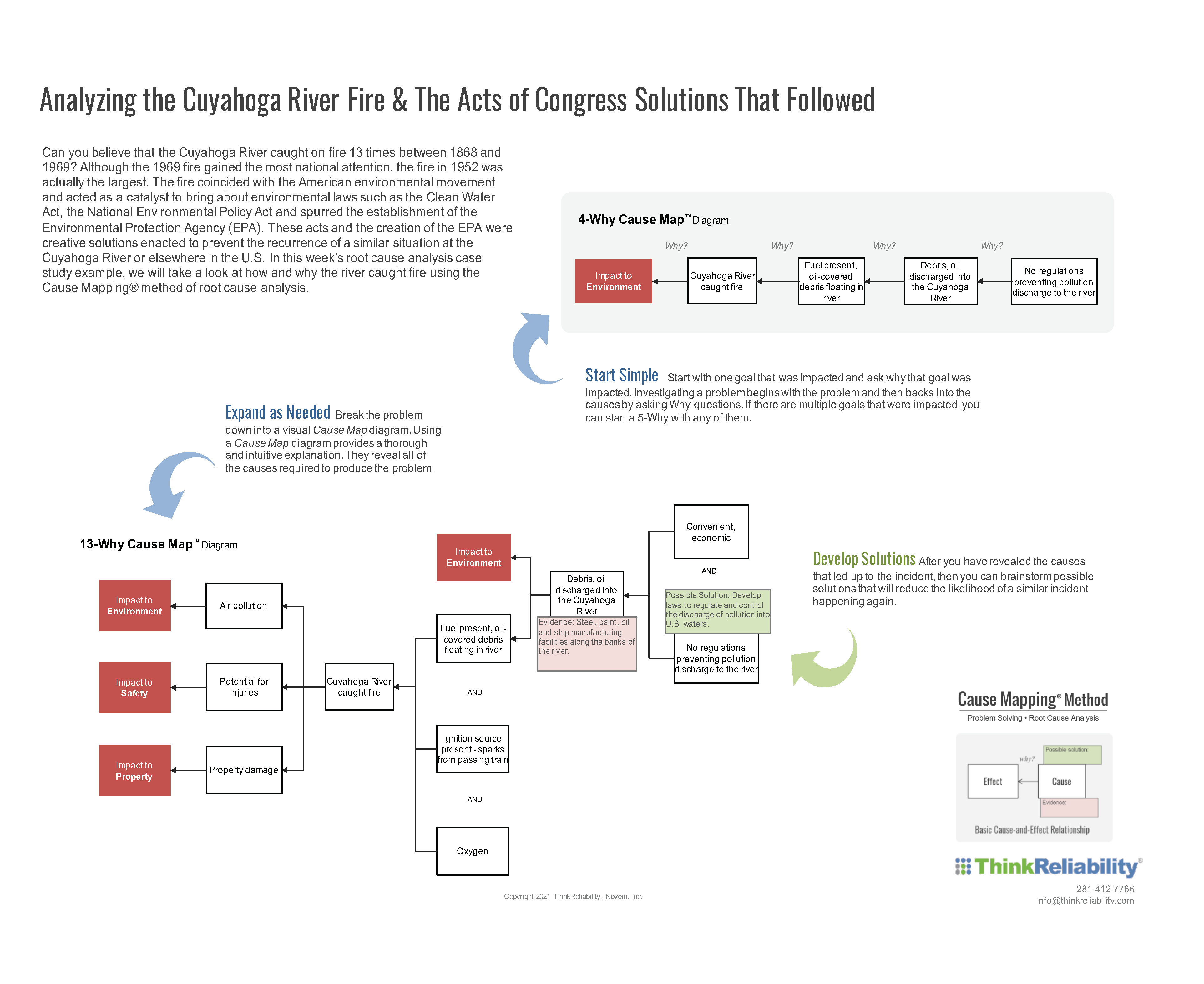Can you believe that the Cuyahoga River caught on fire 13 times between 1868 and 1969? Although the 1969 fire gained the most national attention, the fire in 1952 was actually the largest. The fire coincided with the American environmental movement and acted as a catalyst to bring about environmental laws such as the Clean Water Act, the National Environmental Policy Act and spurred the establishment of the Environmental Protection Agency (EPA). These acts and the creation of the EPA were creative solutions enacted to prevent the recurrence of a similar situation at the Cuyahoga River or elsewhere in the U.S. In this week’s root cause analysis case study example, we will take a look at how and why the river caught fire using the Cause Mapping® method of root cause analysis.
The Cause Mapping method includes three problem-solving steps: defining the problem, analyzing its causes and finding effective solutions. At ThinkReliability, we use the free Cause Mapping® Investigation Template in Microsoft Excel for evaluating incidents, which you can download here.
Step 1: Define the Problem
First, using the Cuyahoga River environmental case study, we can begin to understand the incident by completing the problem outline. The outline captures the basic information of what happened, when it happened and where it occurred.
The problem outline also states how the event impacted the organization’s zero-based goals. In this case, the organization is the state of Ohio or the general public. Many impacts to the goals can be named in this situation.
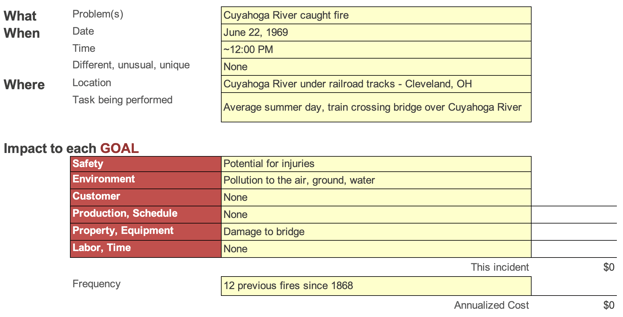
Step 2: Analysis
Next, we conduct the analysis by building a visual cause-and-effect analysis called the Cause Map™ diagram. We do this by using one of the impacted goals and ask Why questions moving to the right. So, we begin with, “Why was there an impact to safety?” The answer, “Because there was a potential for injuries,” goes into the box on the right. When you ask “Why?” again, you get the answer, “Because the Cuyahoga River caught fire.”
For this incident, we find there are multiple impacts to the goals. With the Cause Mapping method, we can include as many as necessary. For example, if we begin with three goals impacted (safety, environment and property), we get the same answer when you ask why there was an impact. So, these three causal paths converge with the “Cuyahoga River caught fire.” (Keep reading to see the PDF with four impacted goals included on the Cause Map diagram.)
The beginning of your Cause Map diagram may look something like this:
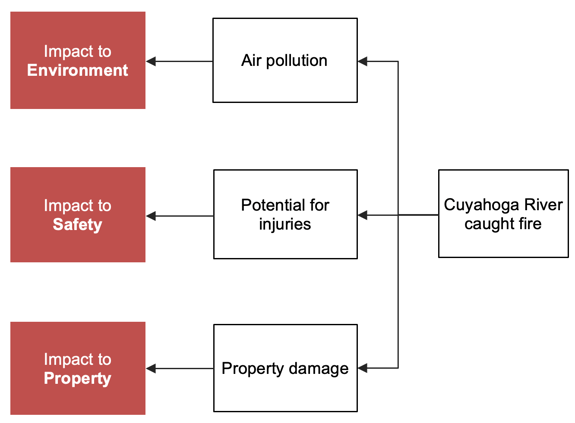
But we are not done! We want to know how and why the river caught fire, so we continue asking Why questions. As with any fire, three things must be present for fire to occur: heat, fuel and oxygen. (Click here for more about the fire triangle and tetrahedron.)
Oxygen – In this scenario, oxygen may seem like a moot point to include. After all, what can you do about oxygen? It’s everywhere. While controlling oxygen might not be possible to prevent the fire from starting, it may be possible to identify solutions that control oxygen to put the fire out. We often overlook causes that are obvious, but sometimes that is where the creative solutions reside.
Fuel – The Cuyahoga River runs through Cleveland, Ohio and during the time of the fires, was home to booming industrial steel, paint, oil and ship manufacturing facilities. Prior to the environmental laws and regulations of the 1970s, very few pollution control measures were in place. Industrial facilities were allowed to dump their waste into rivers. Environmental, health and safety side effects aside, it was a convenient and economic way to dispose of waste. The pollution in the river provided a 24-hour source of fire fuel.
Heat – The last third of the triangle falls into place when a train crosses a railroad trestle going over the river –creating sparks. One of those sparks landed on a piece of oil-slicked debris… and the rest is history. Using this information, we can sum up why the Cuyahoga River caught on fire in a 6-Why Cause Map diagram.
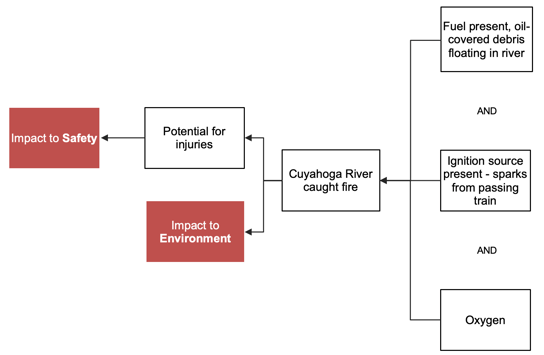
Of course, this incident is complex and has significant repercussions. The 3-Why expanded into a 6-Why, and it can be broken up into additional causes by including additional detail. Every incident can and should be worked to the level of detail needed in order to find effective solutions.
Step 3: Determine Solutions
The third step is to develop possible solutions that will prevent or reduce the likelihood of a similar event from recurring. The purpose of the analysis is to uncover opportunities to control the causes of an incident. The Cuyahoga River fire is a well-documented event that led to some of the biggest and most comprehensive solutions–new U.S. laws and regulations. Click on the thumbnail below to download a 13-Why Cause Map diagram of the incident.
Of course, not all solutions have to take an Act of Congress to implement. Some can be as simple as painting a tripping hazard yellow, removing a tripping hazard altogether or installing a sign to “watch your step.” The best solutions add layer(s) of protection to reduce risk.
For more information about analyzing incidents to reduce risk and add layers of protection, sign up for one of our upcoming training offerings.

